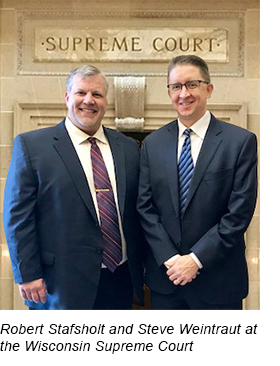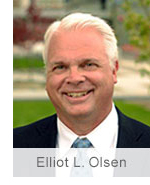|
Welcome to the Siegel Brill newsletter.
Knowing you and your businesses is our goal at Siegel Brill. There are always interesting things happening at our firm and people willing to share their knowledge; some of which just might benefit your business. We hope you enjoy our newsletter and getting to know us just a little better.
 Steve Weintraut’s Client Robert Stafsholt Prevails Against Bank of America at the Wisconsin Supreme Court. Steve Weintraut’s Client Robert Stafsholt Prevails Against Bank of America at the Wisconsin Supreme Court.
Robert Stafsholt was elected to represent the 29th Assembly District in the Wisconsin State Assembly in November, 2016, and since then he has been involved in developing Wisconsin state law in the legislative branch of state government. In March of this year, Stafsholt also helped develop state law in the judicial branch, when he obtained a favorable ruling from the Wisconsin Supreme Court in a mortgage foreclosure action that Bank of America (“BoA”) brought against him and his ex-wife Colleen more than seven years earlier.
Stafsholt hired Steve Weintraut to represent him against Bank of America at trial.
After BoA sued Stafsholt and was demanding that Stafsholt pay what he thought were improper charges or lose his home, Stafsholt sought an experienced and aggressive trial attorney to represent him.
“When I asked a local banker if he knew an attorney referral for this case, he gave me Steve's name and contact information,” says Robert Stafsholt. “The banker told me that Steve represented a party that had counter-sued his bank and in his opinion, bested the bank’s attorney. He also told me that the bank rarely loses and was impressed with Steve’s ability.”
After a Trial in 2014 and a Court of Appeals decision two years later, in March of 2018, the Wisconsin Supreme Court ruled in Stafsholt’s favor in two important ways.
- The Court decided for the first time that under Wisconsin law, attorney’s fees may be awarded as an equitable remedy, and that BoA’s successor, Nationstar Mortgage, had to pay Stafsholt’s attorney’s fees and costs that he had incurred in the foreclosure action.
- The Court ruled that the case should be remanded to the Circuit Court for calculation of the correct amount owed by Nationstar after accounting for Nationstar’s payment of Stafsholt’s attorney’s fees, with “all orders necessary to terminate the mortgage.”
Stafsholt did not prevail on the less important issue of whether Nationstar could collect interest during the lawsuit. But he is still very pleased with the end result, and with Steve Weintraut’s representation of him.
“Working with Steve has been a rock solid and steady team effort the entire time,” says Robert Stafsholt. “Steve explained things very well so I could make appropriate decisions. He had me come into the office and go over everything and we agreed to work together. I never looked back or questioned that decision once over the years it has taken to reach this point in the case.”
CLICK TO READ MORE
The challenges of representing PI clients in jurisdictions other than Minnesota
 Elliot Olsen has been representing serious injury victims for nearly 30 years. He takes on cases all over the United States. Below are some questions that Elliot frequently answers about practicing law outside of the state of Minnesota. Elliot Olsen has been representing serious injury victims for nearly 30 years. He takes on cases all over the United States. Below are some questions that Elliot frequently answers about practicing law outside of the state of Minnesota.
Referring attorneys and clients often ask Elliot questions regarding representing clients in states where he is not licensed. He has answered some of the most common questions are listed below:
Q: How do you know what the laws are in states other than Minnesota?
A: When I represent clients in states other than where I am licensed (Minnesota and Iowa) I get admitted for that a particular case pro hac vice. This means that I get admitted to practice law in that state for only one particular case. Most states require that I hire another lawyer that is licensed in that jurisdiction to help me get “leave of court” to and to be admitted pro hac vice. Even with a local attorney on board, I do the vast majority of the work on the case.
Q: How do you choose the lawyers you work with?
A: This can be tricky. I usually try to get a recommendation from another Minnesota lawyer regarding a good referral for that particular jurisdiction. Then I vet the attorney using information found on the internet. I then call them for a phone interview. If it seems like a good fit and all these things fall in place, then I hire them.
If I can’t find a referral, I use the internet to find attorneys who clearly have a successful practice. One of the criteria I use is whether they are on the SuperLawyers list. Usually I have good instincts based on the lawyer’s website and the type of relevant information I find there. It is rare that I can find someone that has experience in Legionnaires’ Disease or foodborne illness, so I usually try to find a lawyer who works on the plaintiff side doing complex personal injury work and products liability.
Q: How do you split fees?
A: In some instances l pay that lawyer by the hour, and other times we enter into an agreement to split the contingency fee. As noted, in the vast majority of cases I set it up so that Siegel Brill is doing the lion’s share of the work — the “heavy lifting” so to speak. The local lawyer is there to help us navigate who the local judges are, and what the local rules are. The terms are spelled out in the retainer agreement so the client can clearly see who is doing what type of work and how the fees are split.
Q: What are some of the biggest differences in working in states other than Minnesota?
A: Some states still have legal systems that are very different and seem archaic to us. Their systems are heavily based on the English common law; Pennsylvania is one good example. Others like Louisiana have tort systems based on the Napoleonic code, which is also quite unusual. Those are two jurisdictions where it is especially important to have excellent local counsel.
For each jurisdiction, I research the law of products liability myself. The procedural part is where the local counsel is needed for their expertise. I enjoy the challenge of working in other jurisdictions as well and taking on something new and different.
Q: Is there any state that has a legal system that is easier to navigate than Minnesota?
A: New York State is very easy to work in. There are not very many requirements there; not many hoops to jump through in order to get to trial. The downside of the state courts in New York is that it can take a very long time to get to trial and can be a very long road.
Q: What are the benefits of having a case based in Minnesota?
A: It’s refreshing to have a client with a case in Minnesota because I know everything I need to know about working in this state and don’t need any outside counsel. There are still hoops to jump through, of course, but I know what they are and I have the complete skill set to handle any of type of PI case in Minnesota.
Q: How much do you have to travel when you represent clients all over the nation?
A: Because many judges will allow attorneys to do the routine court appearances by telephone, I am able to keep my travel to a minimum, which is only one or two trips a month. I have yet to find a state that won’t allow a phone call for a routine court appearance.
I almost always travel for a deposition because I feel that it is so important to see someone face to face. Even videoconferencing isn’t optimal for depositions in my opinion. I don’t think it will ever take the place of a face to face meeting where you can really look someone in the eye and size them up.
Q: Do you use video conferencing for the initial client interview and what does the initial interview process entail?
A: I start with a short phone conference to determine whether the client has a case. Then, if I decide I want to represent them, I set up a time to talk to them soon thereafter and we’ll have a lengthy phone conference that lasts between one and two hours. During this conversation we discuss all the details of the case. Then if it is the right case, I schedule a trip within the next few days to meet with the people in person to learn more.
Q: What is the cost of your initial conversation with a potential client?
A: All of my cases are contingency fee work so there is no upfront cost. There are no costs until the case is settled no matter which jurisdiction the case is in.
|

